Airport powerpoint
Download as ppt, pdf1 like3,999 views
ž¬ž¬žŁž»ž½ ž¦┘ä┘łž½┘Ŗ┘éž® ž╣┘å ž▒žŁ┘äž® ž│┘üž▒ žź┘ä┘ē ž¦┘ä┘ģžĘž¦ž▒žī žŁ┘Ŗž½ ┘Ŗž¬žŁž»ž½ ž¦┘äž┤ž«žĄ ž╣┘å ž▒ž║ž©ž® ┘ü┘Ŗ ž¦ž│ž¬ž«ž»ž¦┘ģ ┘ģ┘ł┘é┘ü ž¦┘äž│┘Ŗž¦ž▒ž¦ž¬ ┘łž«ž»┘ģž¦ž¬ ž│┘Ŗž¦ž▒ž¦ž¬ ž¦┘䞯ž¼ž▒ž®. ┘ā┘ģž¦ ┘Ŗž┤┘Ŗž▒ žź┘ä┘ē žŻ┘ć┘ģ┘Ŗž® ž¼┘łž¦ž▓ ž¦┘äž│┘üž▒ ┘łž¬ž░ž¦┘āž▒ ž¦┘äžĘž¦ž”ž▒ž® ┘ä┘äžź┘é┘䞦ž╣. ┘Ŗž¬žČ┘ģ┘å ž¦┘ä┘åžĄ žŻ┘ŖžČ┘ŗž¦ ž¬┘üž¦žĄ┘Ŗ┘ä ž╣┘å ž¦┘垬žĖž¦ž▒┘ć┘ģ ┘ü┘Ŗ žĄž¦┘äž® ž¦┘ä┘ģžĘž¦ž▒ ┘łž¦ž│ž¬ž╣ž»ž¦ž»ž¦ž¬┘ć┘ģ ┘ä┘äž│┘üž▒.
1 of 12
Downloaded 208 times

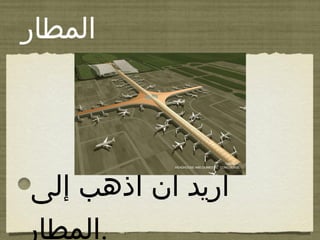


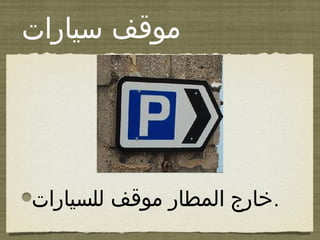

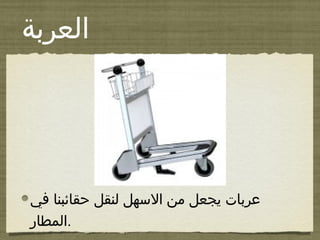

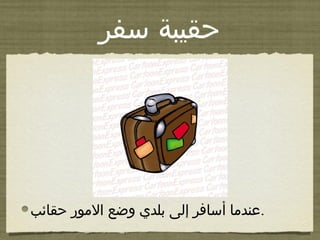


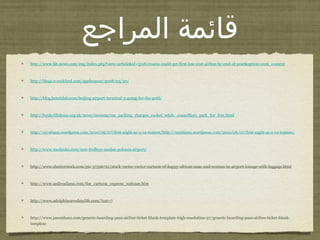
Ad
Recommended
Dubai Airport & City Guide
Dubai Airport & City GuideMedia Labs LLC / Propertyonline.ae / Property Times Magazine
╠²
ž¬┘éž»┘ģ ž¦┘ä┘łž½┘Ŗ┘éž® ┘ģž╣┘ä┘ł┘ģž¦ž¬ ž┤ž¦┘ģ┘äž® ž╣┘å ┘ģžĘž¦ž▒ ž»ž©┘Ŗ ž¦┘äž»┘ł┘ä┘Ŗžī ž©┘ģž¦ ┘ü┘Ŗ ž░┘ä┘ā ž¬┘üž¦žĄ┘Ŗ┘ä ž╣┘å ž¦┘äž«ž»┘ģž¦ž¬ ž¦┘ä┘ģ┘éž»┘ģž® ┘ä┘ä┘ģž│ž¦┘üž▒┘Ŗ┘åžī ž«┘Ŗž¦ž▒ž¦ž¬ ž¦┘ä┘å┘é┘äžī žźž¼ž▒ž¦žĪž¦ž¬ ž¬ž│ž¼┘Ŗ┘ä ž¦┘ä┘łžĄ┘ł┘äžī ┘łžŻ┘ģž¦┘ā┘å ž¦┘䞬ž│┘ł┘é ┘łž¦┘ä┘ģžĘž¦ž╣┘ģ. ┘Ŗž¬žČ┘ģ┘å ž¦┘ä┘ģžĘž¦ž▒ ž½┘䞦ž½ž® ┘ģž©ž¦┘å┘Źžī ┘ł┘Ŗž«ž»┘ģ žŻ┘āž½ž▒ ┘ģ┘å 70 ┘ģ┘ä┘Ŗ┘ł┘å ┘ģž│ž¦┘üž▒ ž│┘å┘ł┘Ŗ┘ŗž¦ žź┘ä┘ē žŻ┘āž½ž▒ ┘ģ┘å 270 ┘łž¼┘ćž® žŁ┘ł┘ä ž¦┘äž╣ž¦┘ä┘ģ. ┘ā┘ģž¦ ┘Ŗ┘ł┘üž▒ ž¦┘ä┘ģžĘž¦ž▒ ┘ģž¼┘ģ┘łž╣ž® ┘ģ┘å ž¦┘äž«ž»┘ģž¦ž¬ ž¦┘äžźžČž¦┘ü┘Ŗž® ┘ģž½┘ä ž«ž»┘ģž¦ž¬ ž░┘ł┘Ŗ ž¦┘䞦žŁž¬┘Ŗž¦ž¼ž¦ž¬ ž¦┘äž«ž¦žĄž® ┘łž¦┘䞦ž¬žĄž¦┘ä ž©ž¦┘äžź┘垬ž▒┘垬.ž¦┘ä┘ģžĘž¦ž▒ž¦ž¬ 1
ž¦┘ä┘ģžĘž¦ž▒ž¦ž¬ 1dossa alfahal
╠²
ž¬ž¬┘垦┘ł┘ä ž¦┘ä┘łž½┘Ŗ┘éž® ┘ģž╣┘ä┘ł┘ģž¦ž¬ ž╣┘å ž¦┘ä┘ģžĘž¦ž▒ž¦ž¬žī ┘ģž╣ ž¦┘䞬ž▒┘ā┘Ŗž▓ ž╣┘ä┘ē ┘ģž▒ž¦┘ü┘é ž¦┘äžź┘é┘䞦ž╣ ┘łž¦┘ä┘ćž©┘łžĘ ž¦┘äž«ž¦žĄž® ž©┘枦 ┘ł┘ģ┘Ŗž▓ž¦ž¬┘枦. ┘ā┘ģž¦ ž¬┘łžČžŁ ž»┘łž▒ ž┤ž▒┘āž¦ž¬ ž¦┘äžĘ┘Ŗž▒ž¦┘å ┘ü┘Ŗ žźž»ž¦ž▒ž® ž¦┘ä┘ģžĘž¦ž▒ž¦ž¬ ┘łž«ž»┘ģž¦ž¬┘枦 ž¦┘ä┘ģž«ž¬┘ä┘üž® ┘ģž½┘ä ž¦┘䞬┘ģ┘ł┘Ŗ┘å ┘łž¦┘䞥┘Ŗž¦┘åž®. ž¬ž┤┘ģ┘ä ž¦┘ä┘łž½┘Ŗ┘éž® žŻ┘ŖžČ┘ŗž¦ žŻ┘ģž½┘äž® ┘ä┘ģžĘž¦ž▒ž¦ž¬ ž╣ž¦┘ä┘ģ┘Ŗž® ž©ž¬žĄž¦┘ģ┘Ŗ┘ģ ┘ģž╣┘ģž¦ž▒┘Ŗž® ž©ž¦ž▒ž▓ž®.Annex 14 ICAO ( Arabic Version ) ž¦┘äžźžĄž»ž¦ž▒ ž¦┘äž╣ž▒ž©┘Ŗ
Annex 14 ICAO ( Arabic Version ) ž¦┘äžźžĄž»ž¦ž▒ ž¦┘äž╣ž▒ž©┘ŖHossam Shafiq I
╠²
Volume I: Aerodrome Design and Operations
ž¦┘ä┘ģž¼┘äž» ž¦┘䞯┘ł┘ä: ž¬ž«žĘ┘ŖžĘ ┘łž¬žĄ┘ģ┘Ŗ┘ģ ž¦┘ä┘ģžĘž¦ž▒ž¦ž¬ Cubism
Cubism16dnh
╠²
Cubism is an abstract art form developed in the early 1900s where objects are broken up and reassembled from different perspectives. Pablo Picasso, a Spanish artist living in France, was a pioneer of cubism and was heavily influenced by Post-Impressionist Paul C├®zanne. One of Picasso's famous cubist works is his portrait of his lover Dora Maar with a cat on her shoulders, which breaks apart their forms and reconstructs them from multiple angles.Ancient greece
Ancient greece16dnh
╠²
Ancient Greece is the location discussed in the document. Key aspects summarized include democracy originating in ancient Athens and Sparta, the Hippocratic Oath guiding physicians, and oracles like those at Dodona providing guidance through prophecies. Architecture is also discussed, noting famous classical orders of columns and art depicting Greek gods like Zeus and sculptures being painted in vivid colors originally.Ancient greece presentation
Ancient greece presentation16dnh
╠²
This document provides an overview of ancient Greece, including its location in the Mediterranean region. It discusses aspects of Greek culture such as the Hippocratic Oath in medicine, the development of democracy in Athens and Sparta, and education practices. The document also describes Greek architecture, art, religion, and mythology. Key figures mentioned include Aristotle and sites referenced include Delphi, Dodona, and temples to the Greek gods.Zakah
Zakah16dnh
╠²
Zakah is an obligatory charity in Islam that Muslims must pay if they have wealth exceeding a minimum amount. It is one of the five pillars of Islam. Zakah purifies wealth and benefits the poor and needy in society by redistributing wealth in a manner that reduces inequality. It is paid annually on money, business inventory, crops, cattle, treasures, minerals, and metals based on set percentages of accumulated wealth.Bass drum
Bass drum16dnh
╠²
The bass drum was invented in Ontario, Canada in the 1930s. It originated as a long drum but was shortened and widened over the 19th century. The bass drum is used in orchestras and bands to mark or keep time in a variety of musical styles like orchestral, jazz, and marching music. It is played by striking the center of the drum head with a mallet and is part of the percussion family of instruments.Bass drum
Bass drum16dnh
╠²
The bass drum was invented in Ontario, Canada in the 1930s. It originated as a long drum but was shortened and widened over the 19th century. The bass drum is used in orchestras and bands to mark or keep time in a variety of musical styles like orchestral, jazz, and marching music. It is played by striking the center of the drum head with a mallet and is part of the percussion family of instruments.Garbage to gems finished
Garbage to gems finished16dnh
╠²
The document summarizes inferences that can be made about an ancient civilization based on 9 everyday items found preserved from that time. It indicates the civilization had the capability to produce: aluminum cans, screws, plastic sunglasses, cardboard packaging, paper catalogs, greeting cards, plastic scissors, plastic rings, and paper currency. This suggests they had advanced manufacturing including machinery to extract and process metals and crude oil, as well as print, mold, and assemble a variety of materials. The presence of English writing on several items also implies the civilization was literate in that language.Garbage to gems finished
Garbage to gems finished16dnh
╠²
The document summarizes inferences that can be made about an ancient civilization based on 9 everyday items found in an archaeological dig:
1. The civilization had the technology to extract aluminum, print colors, and seal containers based on an aluminum can.
2. They understood metallurgy and had tools based on a rusty screw.
3. Plastic baby sunglasses indicate they had oil refining, understood English and eye health.
4. A cracker box shows international trade, agriculture, and machinery for processing, packaging and recycling.Bass drum
Bass drum16dnh
╠²
The bass drum was invented in Ontario, Canada in the 1930s. It originated as a long drum but was shortened and widened over the 19th century. The bass drum is used in orchestras and bands to mark or keep time in a variety of musical styles like orchestral, jazz, and marching music. It is played by striking the center of the drum head with a mallet and is part of the percussion family of instruments.Garbage to gems
Garbage to gems16dnh
╠²
The document summarizes artifacts found that provide insight into an ancient civilization. It includes 9 items: an aluminum can, screw, baby sunglasses, cracker bread box, Playmobil catalog, card, zigzag scissors, plastic ring with strap, and paper bill. The artifacts indicate the civilization had the ability to extract materials like aluminum and iron, manufacture plastic, print materials, use advanced agricultural techniques, and had a monetary system. They displayed skills in engineering, toolmaking, and trade between countries. The variety of items suggests the civilization was technologically advanced with complex infrastructure.Aztec presentation 3
Aztec presentation 316dnh
╠²
The Aztec civilization was located in central Mexico around Lake Texcoco. Their education system emphasized oral communication since their Nahuatl language was not written until Spanish conquest. There were two main types of schools - the telpochcalli focused on practical skills and military training, while the calmecac provided advanced learning. Schools were separated by social class and gender, with noble children attending schools attached to temples. Commoners went to local schools. Children who disobeyed faced punishments like inhaling spicy smoke or being pinched.Savanna
Savanna16dnh
╠²
The savannas are located in Africa, South America, Australia and parts of India. Animals in the savanna have developed adaptations like cheek pockets in baboons to store food and razor sharp teeth to defend against predators. Savanna plants also have adaptations like the baobab tree storing water in its thick trunk to survive dry seasons. However, human activities like fires, agriculture and hunting are threatening savanna ecosystems.Savanna
Savanna16dnh
╠²
The savannas are located in Africa, South America, Australia and parts of India. Animals in the savanna have developed adaptations like cheek pockets in baboons to store food and razor sharp teeth to defend against predators. Savanna plants also have adaptations like the baobab tree storing water in its thick trunk to survive dry seasons. However, human activities like fires, agriculture and hunting are threatening savanna ecosystems.More Related Content
More from 16dnh (10)
Zakah
Zakah16dnh
╠²
Zakah is an obligatory charity in Islam that Muslims must pay if they have wealth exceeding a minimum amount. It is one of the five pillars of Islam. Zakah purifies wealth and benefits the poor and needy in society by redistributing wealth in a manner that reduces inequality. It is paid annually on money, business inventory, crops, cattle, treasures, minerals, and metals based on set percentages of accumulated wealth.Bass drum
Bass drum16dnh
╠²
The bass drum was invented in Ontario, Canada in the 1930s. It originated as a long drum but was shortened and widened over the 19th century. The bass drum is used in orchestras and bands to mark or keep time in a variety of musical styles like orchestral, jazz, and marching music. It is played by striking the center of the drum head with a mallet and is part of the percussion family of instruments.Bass drum
Bass drum16dnh
╠²
The bass drum was invented in Ontario, Canada in the 1930s. It originated as a long drum but was shortened and widened over the 19th century. The bass drum is used in orchestras and bands to mark or keep time in a variety of musical styles like orchestral, jazz, and marching music. It is played by striking the center of the drum head with a mallet and is part of the percussion family of instruments.Garbage to gems finished
Garbage to gems finished16dnh
╠²
The document summarizes inferences that can be made about an ancient civilization based on 9 everyday items found preserved from that time. It indicates the civilization had the capability to produce: aluminum cans, screws, plastic sunglasses, cardboard packaging, paper catalogs, greeting cards, plastic scissors, plastic rings, and paper currency. This suggests they had advanced manufacturing including machinery to extract and process metals and crude oil, as well as print, mold, and assemble a variety of materials. The presence of English writing on several items also implies the civilization was literate in that language.Garbage to gems finished
Garbage to gems finished16dnh
╠²
The document summarizes inferences that can be made about an ancient civilization based on 9 everyday items found in an archaeological dig:
1. The civilization had the technology to extract aluminum, print colors, and seal containers based on an aluminum can.
2. They understood metallurgy and had tools based on a rusty screw.
3. Plastic baby sunglasses indicate they had oil refining, understood English and eye health.
4. A cracker box shows international trade, agriculture, and machinery for processing, packaging and recycling.Bass drum
Bass drum16dnh
╠²
The bass drum was invented in Ontario, Canada in the 1930s. It originated as a long drum but was shortened and widened over the 19th century. The bass drum is used in orchestras and bands to mark or keep time in a variety of musical styles like orchestral, jazz, and marching music. It is played by striking the center of the drum head with a mallet and is part of the percussion family of instruments.Garbage to gems
Garbage to gems16dnh
╠²
The document summarizes artifacts found that provide insight into an ancient civilization. It includes 9 items: an aluminum can, screw, baby sunglasses, cracker bread box, Playmobil catalog, card, zigzag scissors, plastic ring with strap, and paper bill. The artifacts indicate the civilization had the ability to extract materials like aluminum and iron, manufacture plastic, print materials, use advanced agricultural techniques, and had a monetary system. They displayed skills in engineering, toolmaking, and trade between countries. The variety of items suggests the civilization was technologically advanced with complex infrastructure.Aztec presentation 3
Aztec presentation 316dnh
╠²
The Aztec civilization was located in central Mexico around Lake Texcoco. Their education system emphasized oral communication since their Nahuatl language was not written until Spanish conquest. There were two main types of schools - the telpochcalli focused on practical skills and military training, while the calmecac provided advanced learning. Schools were separated by social class and gender, with noble children attending schools attached to temples. Commoners went to local schools. Children who disobeyed faced punishments like inhaling spicy smoke or being pinched.Savanna
Savanna16dnh
╠²
The savannas are located in Africa, South America, Australia and parts of India. Animals in the savanna have developed adaptations like cheek pockets in baboons to store food and razor sharp teeth to defend against predators. Savanna plants also have adaptations like the baobab tree storing water in its thick trunk to survive dry seasons. However, human activities like fires, agriculture and hunting are threatening savanna ecosystems.Savanna
Savanna16dnh
╠²
The savannas are located in Africa, South America, Australia and parts of India. Animals in the savanna have developed adaptations like cheek pockets in baboons to store food and razor sharp teeth to defend against predators. Savanna plants also have adaptations like the baobab tree storing water in its thick trunk to survive dry seasons. However, human activities like fires, agriculture and hunting are threatening savanna ecosystems.Airport powerpoint
- 2. ŌĆ½ž¦┘ä┘ģžĘž¦ž▒ŌĆ¼ ŌĆ½žź┘ä┘ēŌĆ¼ ŌĆ½žŻž░┘ćž©ŌĆ¼ ŌĆ½žŻ┘åŌĆ¼ ŌĆ½žŻž▒┘Ŗž»ŌĆ¼ ŌĆ½.ž¦┘ä┘ģžĘž¦ž▒ŌĆ¼
- 3. ŌĆ½žĘž¦ž”ž▒ž®ŌĆ¼ ŌĆ½žĘž¦ž”ž▒ž®ŌĆ¼ ŌĆ½┘ü┘ŖŌĆ¼ ŌĆ½ž¦┘äž│┘üž▒ŌĆ¼ ŌĆ½.žŻžŁž©ŌĆ¼
- 4. ŌĆ½ž│┘üž▒ŌĆ¼ ŌĆ½ž¼┘łž¦ž▓ŌĆ¼ ŌĆ½┘ä┘äž│┘üž▒ŌĆ¼ ŌĆ½ž│┘üž▒ŌĆ¼ ŌĆ½ž¼┘łž¦ž▓ŌĆ¼ ŌĆ½žź┘ä┘ēŌĆ¼ ŌĆ½.žŻžŁž¬ž¦ž¼ŌĆ¼
- 5. ŌĆ½ž│┘Ŗž¦ž▒ž¦ž¬ŌĆ¼ ŌĆ½┘ģ┘ł┘é┘üŌĆ¼ ŌĆ½┘ä┘äž│┘Ŗž¦ž▒ž¦ž¬ŌĆ¼ ŌĆ½┘ģ┘ł┘é┘üŌĆ¼ ŌĆ½ž¦┘ä┘ģžĘž¦ž▒ŌĆ¼ ŌĆ½.ž«ž¦ž▒ž¼ŌĆ¼
- 6. ŌĆ½ž│┘Ŗž¦ž▒ž®ŌĆ¼ŌĆ½žŻž¼ž▒ž®ŌĆ¼ ŌĆ½ž│┘Ŗž¦ž▒ž¦ž¬ŌĆ¼ ŌĆ½┘ģ┘åŌĆ¼ ŌĆ½ž¦┘ä┘āž½┘Ŗž▒ŌĆ¼ ŌĆ½ž¦┘ä┘ģžĘž¦ž▒ŌĆ¼ ŌĆ½ž«ž¦ž▒ž¼ŌĆ¼ ŌĆ½.ž¦┘äž¼ž▒ž®ŌĆ¼
- 7. ŌĆ½ž¦┘äž╣ž▒ž©ž®ŌĆ¼ ŌĆ½┘ü┘ŖŌĆ¼ ŌĆ½žŁ┘鞦ž”ž©┘垦ŌĆ¼ ŌĆ½┘ä┘å┘é┘äŌĆ¼ ŌĆ½ž¦┘ä┘ćž│┘ć┘äŌĆ¼ ŌĆ½┘ģ┘åŌĆ¼ ŌĆ½┘Ŗž¼ž╣┘äŌĆ¼ ŌĆ½ž╣ž▒ž©ž¦ž¬ŌĆ¼ ŌĆ½.ž¦┘ä┘ģžĘž¦ž▒ŌĆ¼
- 8. ŌĆ½ž¦┘ćž│ž¬ž▒ž¦žŁž®ŌĆ¼ ŌĆ½┘å┘垬žĖž▒ŌĆ¼ ŌĆ½ž©┘Ŗ┘å┘ģž¦ŌĆ¼ ŌĆ½ž¦┘䞥ž¦┘äž®ŌĆ¼ ŌĆ½┘ü┘ŖŌĆ¼ ŌĆ½┘åž¼┘äž│ŌĆ¼ ŌĆ½┘ā┘垦ŌĆ¼ ŌĆ½.ž▒žŁ┘䞬┘垦ŌĆ¼
- 9. ŌĆ½┘ćž│┘üž▒ŌĆ¼ ŌĆ½žŁ┘é┘Ŗž©ž®ŌĆ¼ ŌĆ½žŁ┘鞦ž”ž©ŌĆ¼ ŌĆ½ž¦┘ä┘ģ┘łž▒ŌĆ¼ ŌĆ½┘łžČž╣ŌĆ¼ ŌĆ½ž©┘äž»┘ŖŌĆ¼ ŌĆ½žź┘ä┘ēŌĆ¼ ŌĆ½žŻ┘ćž│ž¦┘üž▒ŌĆ¼ ŌĆ½.ž╣┘åž»┘ģž¦ŌĆ¼
- 10. ŌĆ½ž▒ž¦┘āž©ŌĆ¼ ŌĆ½┘ā┘垬ŌĆ¼ ŌĆ½ž¬ž│ž¦┘üž▒ŌĆ¼ ŌĆ½┘ā┘垬ŌĆ¼ ŌĆ½žźž░ž¦ŌĆ¼ ŌĆ½ž▒ž¦┘āž©ŌĆ¼
- 11. ŌĆ½ž¼┘łž¦ž▓ŌĆ¼ŌĆ½ž¦┘ä┘ģž▒┘łž▒ŌĆ¼ŌĆ½ž╣┘ä┘ēŌĆ¼ŌĆ½┘ģž¬┘åŌĆ¼ŌĆ½ž¦┘äžĘž¦ž”ž▒ž®ŌĆ¼ ŌĆ½ž¦┘䞥ž╣┘łž»ŌĆ¼ ŌĆ½ž¬ž░ž¦┘āž▒ŌĆ¼ ŌĆ½ž╣┘ä┘ēŌĆ¼ ŌĆ½ž¦┘䞣žĄ┘ł┘äŌĆ¼ ŌĆ½ž¦┘ä┘ēŌĆ¼ ŌĆ½žŁž¦ž¼ž®ŌĆ¼ ŌĆ½┘ü┘ŖŌĆ¼ ŌĆ½┘ā┘垬ŌĆ¼ ŌĆ½ž¦┘äžĘž¦ž”ž▒ž®ŌĆ¼ ŌĆ½.ž╣┘ä┘ēŌĆ¼